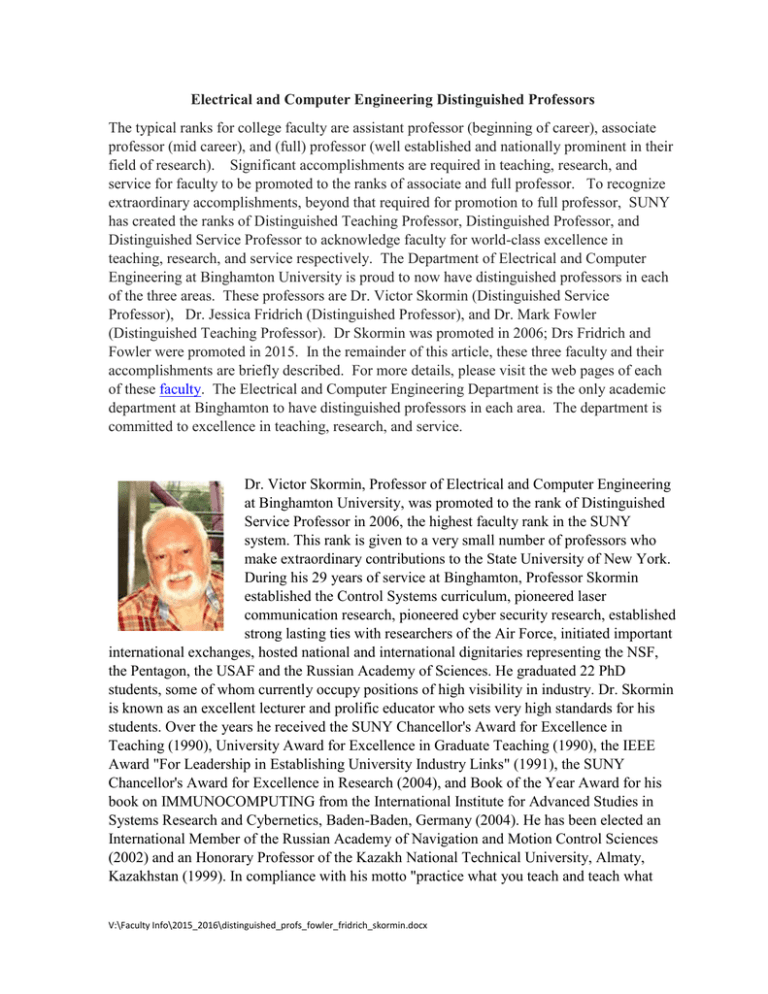Electrical and Computer Engineering Distinguished Professors The
advertisement

Electrical and Computer Engineering Distinguished Professors The typical ranks for college faculty are assistant professor (beginning of career), associate professor (mid career), and (full) professor (well established and nationally prominent in their field of research). Significant accomplishments are required in teaching, research, and service for faculty to be promoted to the ranks of associate and full professor. To recognize extraordinary accomplishments, beyond that required for promotion to full professor, SUNY has created the ranks of Distinguished Teaching Professor, Distinguished Professor, and Distinguished Service Professor to acknowledge faculty for world-class excellence in teaching, research, and service respectively. The Department of Electrical and Computer Engineering at Binghamton University is proud to now have distinguished professors in each of the three areas. These professors are Dr. Victor Skormin (Distinguished Service Professor), Dr. Jessica Fridrich (Distinguished Professor), and Dr. Mark Fowler (Distinguished Teaching Professor). Dr Skormin was promoted in 2006; Drs Fridrich and Fowler were promoted in 2015. In the remainder of this article, these three faculty and their accomplishments are briefly described. For more details, please visit the web pages of each of these faculty. The Electrical and Computer Engineering Department is the only academic department at Binghamton to have distinguished professors in each area. The department is committed to excellence in teaching, research, and service. Dr. Victor Skormin, Professor of Electrical and Computer Engineering at Binghamton University, was promoted to the rank of Distinguished Service Professor in 2006, the highest faculty rank in the SUNY system. This rank is given to a very small number of professors who make extraordinary contributions to the State University of New York. During his 29 years of service at Binghamton, Professor Skormin established the Control Systems curriculum, pioneered laser communication research, pioneered cyber security research, established strong lasting ties with researchers of the Air Force, initiated important international exchanges, hosted national and international dignitaries representing the NSF, the Pentagon, the USAF and the Russian Academy of Sciences. He graduated 22 PhD students, some of whom currently occupy positions of high visibility in industry. Dr. Skormin is known as an excellent lecturer and prolific educator who sets very high standards for his students. Over the years he received the SUNY Chancellor's Award for Excellence in Teaching (1990), University Award for Excellence in Graduate Teaching (1990), the IEEE Award "For Leadership in Establishing University Industry Links" (1991), the SUNY Chancellor's Award for Excellence in Research (2004), and Book of the Year Award for his book on IMMUNOCOMPUTING from the International Institute for Advanced Studies in Systems Research and Cybernetics, Baden-Baden, Germany (2004). He has been elected an International Member of the Russian Academy of Navigation and Motion Control Sciences (2002) and an Honorary Professor of the Kazakh National Technical University, Almaty, Kazakhstan (1999). In compliance with his motto "practice what you teach and teach what V:\Faculty Info\2015_2016\distinguished_profs_fowler_fridrich_skormin.docx you practice" Professor Skormin provided consulting services to the Air Force and several major industries. Dr. Jessica Fridrich, Professor of Electrical and Computer Engineering at Binghamton University until very recently, has been promoted to the rank of Distinguished Professor, the highest faculty rank in the SUNY system. This is the rank given to a very small number of professors who have proven themselves to be renowned international leaders in their area of research. Professor Fridrich’s main research areas are steganography, the science (and art) of message hiding, and the forensics of digital multimedia. Professor Fridrich is viewed by her peers as a “superstar” and the world’s foremost authority in the field of steganography. In 2009, in addition to her many research papers, she published “Steganography in Digital Media: Principles, Algorithms, and Applications,” (Cambridge University Press) which has rapidly become the seminal graduate textbook in steganography. In the area of forensics, she has developed a now patented method for “finger printing” digital photos so that photos can be reliably linked with a camera. Her method is the only one that has been officially approved (it has passed the Daubert Challenge) for use as evidence in forensics cases in a court of law. In total, Professor Fridrich’s research has resulted in over 150 refereed publications, with over 16,000 citations, and seven patents, all of which have been successfully commercialized. Dr. Mark Fowler, Professor of Electrical and Computer Engineering at Binghamton University until very recently, has been promoted to the rank of Distinguished Teaching Professor, the highest faculty rank in the SUNY system. This is the rank given to a very small number of professors who have proven themselves to be renowned engineering educators, both at their home campus and across the nation. On his home campus, Professor Fowler is not only a superlative lecturer, able to hold the attention of classes of well over 100 students, but also sets very high standards for all his students. Over the past five years, he has pioneered the use of flipped classes, with students viewing lectures before class time, and spending class time on problem solving and hands-on exercises. Professor Fowler was instrumental in establishing the BEE online program, the only fully online undergraduate electrical engineering program in the Unites States. His Signals and Systems class remains one of the regular classes in the program. Professor Fowler has published papers regarding his pedagogical methods in leading international conferences. Both current and former students are glowing in their praise of Distinguished Teaching Professor Fowler. V:\Faculty Info\2015_2016\distinguished_profs_fowler_fridrich_skormin.docx
